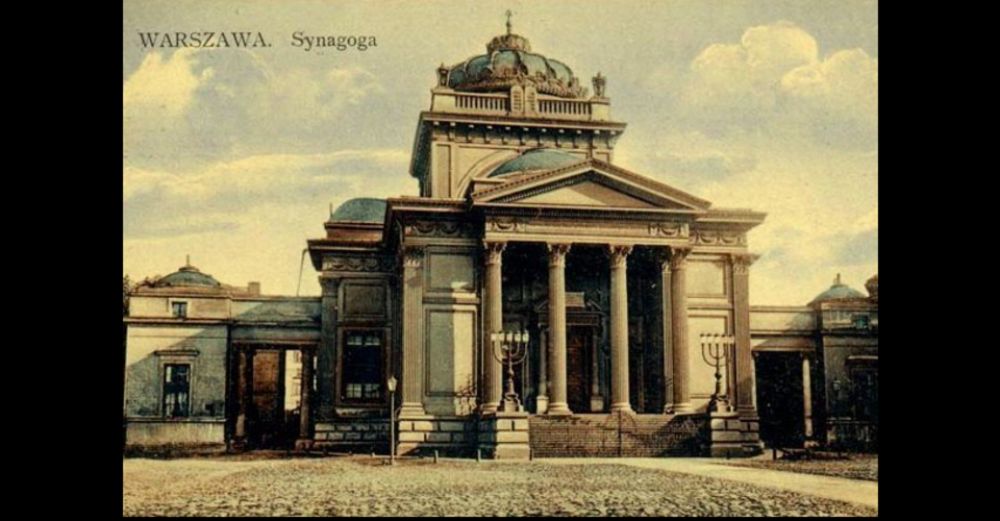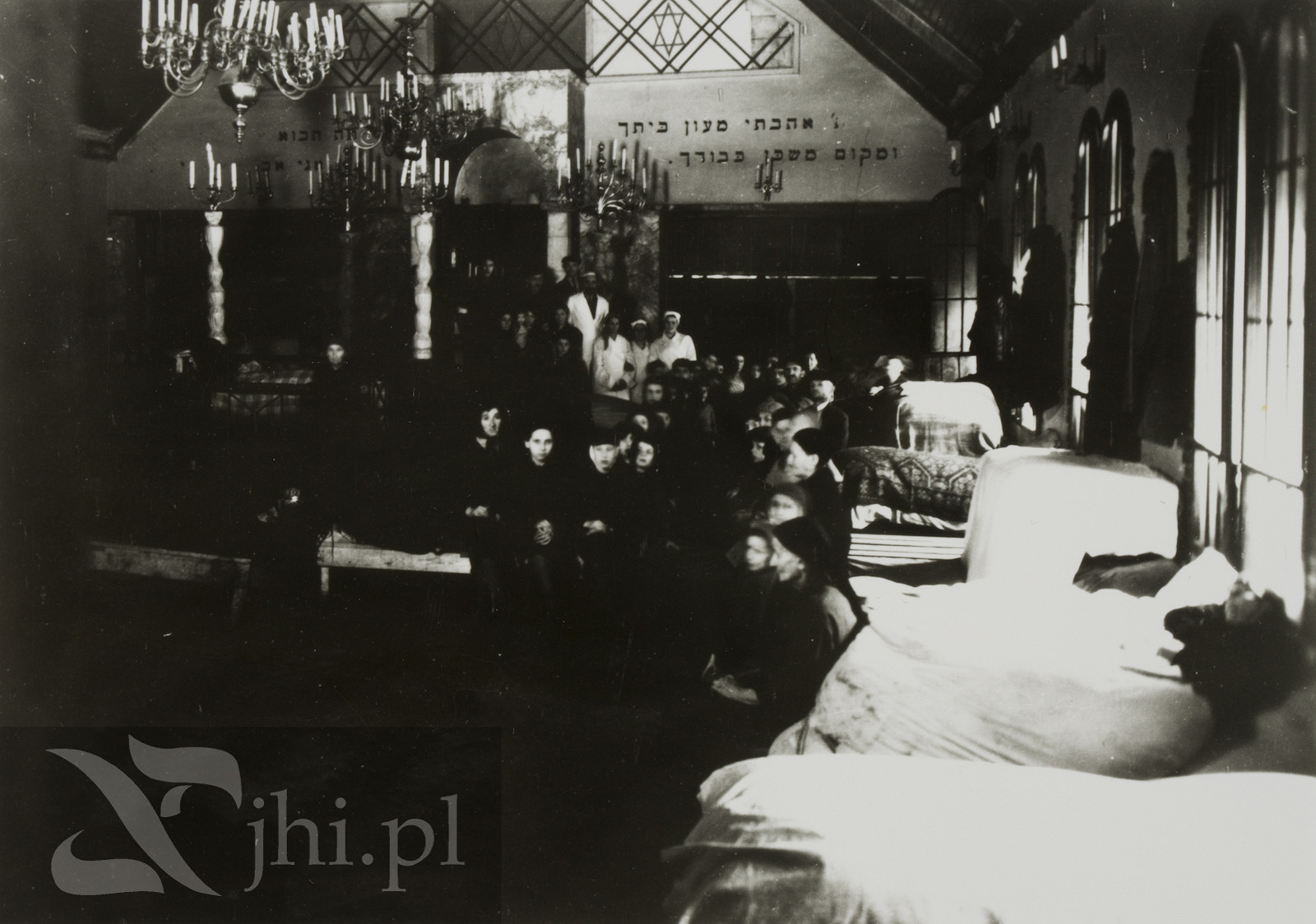- News
- Events
- Oneg Shabbat
- Collections
- Research
- Exhibitions
- Education
- Publishing Department
- Genealogy
- About the Institute
- Bookstore


Until the Second World War, Warsaw was the biggest assembly of Jews in Europe. The Jewish Quarter constituted of almost one fifth of the city. “In Warsaw, which gave way in terms of Jewish population only to New York, Jewish life, both traditional and creative was thriving,” wrote Israel Gutman about pre-war Warsaw in his book “ Resistance: The Warsaw Ghetto Uprising”
“The Jews in Warsaw lacked tradition and character, which were important features of communities in such cities as Cracow, Lublin or Lviv, where the Jews had lived for generations. Warsaw lacked not only old buildings, but also ones shrouded in tradition of the memories of the glorious past. It did not have synagogues dating back to a few centuries as Cracow did. Also, it had never been home to famous Jewish scholars. The Jewish community in Warsaw did not have a long tradition. The oldest gravestone in the Jewish cemetery was from 1807.
“Despite all of this, Warsaw gave the newcomers a chance to play a role in the history of the city. You could feel the spirit of its rapid development. Relatively new development of the city and rapid changes fostered the overcoming of the traditional isolation. The newcomers and temporary guests felt good in this city.”
Warsaw quickly became the world’s cultural capital of the Jewish diaspora. More than 400 synagogues and houses of prayer functioned there. With the outbreak of the Second World War, and later with the increasing repressions from the German occupier, the Jews in Warsaw lost the possibility to function normally, including participation in religious practices in their synagogues. In January 1940, all the synagogues and houses of prayer had been closed. However, on 20th May, 1941, the German authorities, allowed to open three synagogues, which were on the ghetto territory: Moriah Synagogue, the Nożyk Synagogue and the Great Synagogue in Tłomackie.
The Great Synagogue built at 7 Tłomackie Street was one of the greatest Polish buildings erected in the 19th century. The opening ceremony took place on 26th September, 1878, on Rosh Hashanah holiday. During the ceremony, Rabbi Isaac Cylklow welcomed the Russian Governor-General of Warsaw Count Paul Demetrius von Kotzebuenot in Russian, Hebrew and Yiddish, but in Polish, which was received as a permission to preach in that language, as the latter did not protest. The eternal light before Aron Kodesh was lit by Henryk Natanson.
To this day, survived only architectural plans of the synagogue, diagrams and sketches of the ground floor and the level of the gallery for women, and a few postcards depicting the building. However, an expert’s eye, also by looking at them, will notice the similarity of the synagogue to other well-known buildings in Warsaw. Its facade is reminiscent of one of the facades of the Palace on the Isle in Warsaw’s Łazienki Park, and the representative entrance is similar to the colonnade portico of today’s City Hall.
The interior of the Great Synagogue was amazing. A stir among the then synagogues’ goers was caused by its Renaissance style and references to early Christian basilicas. Inside, there were 2200 seats, a library, office rooms and a wedding room. Prominent examples of Italian inspirations were the nave and aisles with the arches of the cloisters, centrally located apse, where the bimah was located (a raised level surface for reading the Torah) and the Aron Kodesh (altar closet to store the Torah). The upper part of the apse was filled with a conch covered with rosettes in the shape of stars. Quite similarly constructed is the entrance to St. Anne’s Church in Wilanów.
The Great Synagogue performed not only religious functions. Also, church services on the occasion of Poland’s resumption of independent statehood, the ratification of the Polish Constitution of May 3, the start of the school year or a memorial service on the day of Pilsudski’s death took place there.
During the Second World War, the building was gradually devastated by the Nazi occupiers. In January 1940, the synagogue had been closed. Then, it was reopened for a short time in November 1941. In March 1942 the area around Tłomackie, including the Great Synagogue, was excluded from the ghetto. The building started to function as a storage for furniture. In the middle of 1942, the roof of the devastated building already had many holes. Most of the furnishing had been taken away or destroyed. The capitals and parts of the architraves were damaged and Aron Kodesh was lying on the floor.
Eventually, the Great Synagogue was blown up on 16th May, 1943, which became the last act of the destruction of the Jewish quarter by the Germans. The only reminders of the most significant Jewish building in Warsaw are parts of a column and a ticket from the cloakroom.
The Nożyk Synagogue at 6 Twarda Street is the only surviving of the most significant synagogues in Warsaw. Services take place there every day and four times a year, the deceased founders, Rywka and Załman Nożyk, are remembered there. The land for the construction of the synagogue at 6 Twarda Street was bought by Załman Nożyk already in 1893. The construction work, based on the plans of architect Karol Kozlowski began in the spring of 1898. After less than a year the building was ready:
“The erection of the new synagogue in Twarda Street funded by Mr Nożyk is not only a project, as daily newspapers state, but accomplished fact as the synagogue is already under roof. [“Izraelita”, 1/3 January, 1899]
The ceremonial opening took place on 12th May 1902 on Lag ba-Omer holiday. Formal speechs were given by two rabbis and cantor Lewinsohn led the prayers. Załman Nożyk, however, solemnly placed the Torah in Aron Kodesh.
The synagogue was built on the area of rectangular shape; it had a risalit in the Romanesque Revival style, with numerous Byzantine neo-Renaissance and Moorish elements. The interior was divided into a nave and two aisles. The synagogue was built for the Orthodox community. It had seats for women in the galleries, which could be entered by separate entrances and stairways. The bimah was slightly shifted towards the center of the main room, and over the finial of Aron Kodes, there was a niche for the choir.
The Nożyk Synagogue had been closed, as all the other houses of prayers, in Januray 1940. It was reopened in September 1941. In July 1942, the synagogue had been closed again and after the liquidation of the Small Ghetto, it was on the Aryan side. It was then that the building was closed down and devastated by the Nazis, who used it as a stable and a depot. During the Warsaw Uprising it was badly damaged but its solid construction did not collapse.
Today, the restored synagogue is not only a place of religious practices but it also hosts many exhibitions, concerts, vernissages and other cultural meetings.
“The new synagogue ‘Morija’. Last month (which means in August), on 28th, the first brick was laid as a part of foundation of a project to be soon executed. As a result of the efforts by a group of Jews, the local inhabitants, a synagogue will be built at 7 Dzielna Street corresponding as much to the requirements of hygiene as to the aesthetic requirements. Due to the acquisition of a house for that purpose, a ceremony took place. The Nozyk Synagogue’s Cantor, Mr. M. Levinson, began singing. Along with the choir he sang the anthem „Ma-towu”. (How beautiful are your tents, O Jacob!) and a few more thanksgiving prayers. After that, a speech was given by a preacher, Mr Nisenbaum. Then, a member of the new synagogue building committee, Mr. M. Pros, explained that the house was purchased in Dzielna for 100,300 rubles and that from 1000 released shares, worth of 100 rubles each, 314 members had bought 438 shares, for a total of rb. 43,800. [“Izraelita” 1904, no. 41]

The synagogue was probably not a new building, but the existing interior was adapted to its needs. Aron Kodesh was a quadrilateral arcade „bower”, covered with a dome and bimah. Symmetrically on both sides menorahs were placed. Inside, a two rows of benches were placed, each of which was designed for eight people. The light shone to the synagogue through casement windows, which could suggest that it was located on a higher floor than the neighboring buildings.
When the occupation of Warsaw by the Germans began, in 1940, the synagogue was closed. During the ceremonial reopening, on 6th September, 1941, the prayers were led by cantor Israel Mowsza Rudnicki with the choir conducted by doctor Gutwerk. The solemn speech was delivered by Rabbi Goldsztejn. In addition, a welcome letter by many years’ preacher, Isaac Nisenbaum, was read. Shortly after the opening, in September 1942, a bomb was dropped on the tenement house and the synagogue, destroying them completely. Muranow area was razed to the ground and today it is difficult to even find a place where the synagogue stood.